List of Philippine dishes
This list is incomplete; you can help by expanding it.

Filipino cuisine

Barbecue and meat on display at a street food stall during the Dinagyang Festival in Iloilo City, Philippines
This is a list of selected dishes found in the Philippines. While the names of some dishes may be the same as dishes in other cuisines, many of them have evolved to mean something distinctly different in the context of Philippine cuisine.
Main dishes
| Name | Image | Region | Type | Description |
|---|---|---|---|---|
| Adobo | 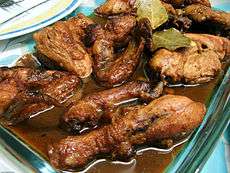 |
Meat dish | Typically pork or chicken, or a combination of both, is slowly cooked in vinegar, cooking oil, crushed garlic, bay leaf, black peppercorns, and soy sauce, and often browned in the oven or pan-fried afterward to get the desirable crisped edges. | |
| Afritada | Meat dish | Chicken and/or pork and potatoes cooked in tomato sauce. | ||
| Asado | Meat dish | Braised meat in a soy sauce and brown sugar liquid. Also refers to dried sweetmeats as well as dried red-colored meats with sweet taste similar to Chinese barbecued pork. A stand-alone dish or used as a filling in asado siopao, a variation on Chinese baozi or steamed filled bun. | ||
| Barbecue |  |
A variety of grilled items such as "Isaw"(Pig/chicken intestines), "Dugo"(Cubes of pork/chicken blood), Tenga (Pig ears), etc. Barbecue is slices of meat (mainly pork) marinated in a sweet soy-garlic mixture, grilled, basted with the marinade and then served with either a soy-vinegar dip or a sweet brown sauce | ||
| Bistek Tagalog (Beef Steak) |  |
Tagalog | Meat dish | Strips of sirloin beef slowly cooked in soy sauce, calamansi juice, and onions. |
| Bopis | Meat dish | A spicy dish made out of pork lungs and heart sautéed in tomatoes, chilies and onions. | ||
| Camaron rebosado | 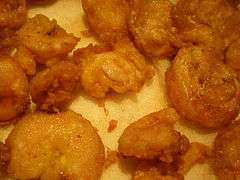 |
Seafood | Deep fried battered shrimps. Similar to Tempura, but with a heavier batter. | |
| Carne norte | Meat dish | Corned beef, usually referring to corned beef hash. | ||
| Chicken pastel | Meat dish | Chicken casserole. | ||
| Crispy pata | 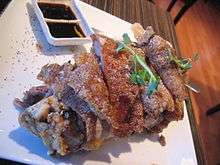 |
Meat dish | Deep fried portions of pork legs including knuckles often served with a chili and calamansi flavored dipping soy sauce or chili flavored vinegar for dipping. | |
| Crispy tadyang ng baka | Meat dish | Crispy beef ribs often served with a chili and calamansi flavored soy sauce or chili flavored vinegar for dipping. | ||
| Curacha | Zamboanga | Seafood | Boiled or steamed sea crab. | |
| Daing |  |
Fish dish | Fish (especially milkfish) that has been dried, salted, or simply marinated in vinegar with lots of garlic and then fried. | |
| Embutido | 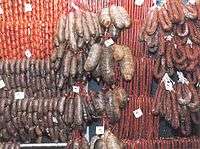 |
Meat dish | A meatloaf shaped in the form of a sausage. | |
| Escabeche |  |
Fish dish | Referring to both a dish of poached or fried fish that is marinated in an acidic mixture before serving, and to the marinade itself. Can refer broadly to sweet and sour dishes. | |
| Giniling (Picadillo) |  |
Meat Dish | Ground pork or beef cooked with garlic, onion, soy sauce, tomatoes, and potatoes and frequently with carrots, raisins, and bell peppers. | |
| Halabos na hipon | Seafood | Shrimps steamed in their own juices and cooked with a little oil. | ||
| Endulsao or Hamonado | Zamboanga City | Meat dish | Pork cooked in pineapple juice and sugar, coated in a sweet sauce. Based on the Glazed Ham. Humba is the Visayan version of the dish. | |
| Inasal na manok | Negros | Meat dish | Grilled chicken marinated in a vinegar marinade. Served with a siding of Atchara and Soy-Vinegar Sauce. | |
| Inihaw na liempo | Meat dish | Grilled pork belly. | ||
| Kadyos Baboy Langka |  |
Iloilo | Meat dish | As the name suggests, it refers to the combination of mainly three ingredients: Kadyos (Pigeon pea), Baboy (Pork) and Langka (Jackfruit). |
| Kadyos Manok Ubad |  |
Iloilo | Meat dish | As the name suggests, it refers to the combination of mainly three ingredients: Kadyos (Pigeon pea), Manok (Chicken) and Ubad (Pith of a banana tree). |
| Kaldereta |  |
Luzon | Meat dish | A dish made with cuts of pork, beef or goat with tomato paste or tomato sauce with liver spread added to it. |
| Kinunot | Bicol | Seafood | From the word kunot which literally means shred. A dish made up of either shredded meat of pagi (stingray) or baby shark cooked in coconut milk with malungay (moringa) leaves. | |
| Lechón | 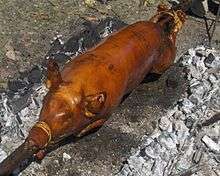 |
Meat dish | A dish made by roasting a whole pig over charcoal. It is often cooked during special occasions. A simpler version has chopped pieces of pork fried in a pan or wok (lechon kawali). Also refers to a spitted and charcoal roasted marinated chicken (lechon manok). | |
| Lengua estafada | Meat dish | Braised ox tongue. | ||
| Lumpia |  |
Meat/Vegetable dish | Spring rolls. Deep fried (prito) or fresh (sariwa). Popular versions include lumpiang shanghai a deep fried meat filled usually fairly narrow spring roll often accompanied by a sweet chili dipping sauce and lumpiang ubod a fresh or sometimes deep fried wider spring roll filled with crunchy vegetables and optionally including cooked meat. | |
| Mechado | Meat dish | Name derived from mitsa meaning "wick" which is what the pork fat inserted into a slab of beef looks like before the larded beef is cooked, sliced, and served in the seasoned tomato sauce it is cooked in. | ||
| Morcon | Meat dish | A beef roulade often prepared for special occasions it consists of thin sheets of cooked eggs and marinated beef layered one on top of the other, then wrapped and tied around carrots, celery, cheese, pork fat, and sausage. This is then cooked in seasoned tomato sauce. | ||
| Paksiw | Generally means to cook and simmer in vinegar. Common dishes bearing the term, however, can vary substantially depending on what is being cooked. Paksiw na isda is fish poached in a vinegar broth usually seasoned with fish sauce and spiced with siling mahaba and possibly containing vegetables. Paksiw na baboy is pork, usually hock or shank, cooked in ingredients similar to those in adobo but with the addition of sugar and banana blossoms to make it sweeter and water to keep the meat moist and to yield a rich sauce. Paksiw na lechon is roasted pork lechon meat cooked in lechon sauce or its component ingredients of vinegar, garlic, onions, black pepper and ground liver or liver spread and some water. The cooking reduces the sauce so that by the end the meat is almost being fried. | |||
| Pata tim | Meat dish | Braised pork leg dish similar to Paksiw na Pata, Chinese style. Simmered in a sweet soy sauce flavored by Chinese herbs such as star anise, banana blossoms, etc. | ||
| Pinakbet |  |
Ilocos | Vegetable dish | A popular Ilocano dish made of different vegetables like okra, eggplant and bitter gourd cooked in fish sauce. |
| Pinangat, Natong, or Laing | 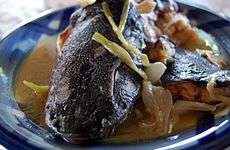 |
Bicol | Vegetable dish | In Bicol refers to a dish of taro leaves, chili, meat, and coconut milk tied securely with coconut leaf. In Manila the dish is known more commonly as laing. Pinangat or pangat also refers to a dish or method of cooking involving poaching fish in salted water and tomatoes. |
| Relleno | Stuffed meat, seafood, or vegetable dishes like rellenong bangus (stuffed milkfish), rellenong manok (stuffed chicken), and rellenong talong (stuffed eggplant) also known as tortang talong (see below). | |||
| Sarsiado | 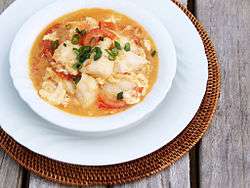 |
Tagalog | Fish dish | Fish that is cooked with tomato sauce and real tomatoes. |
| Sinanglay | Bicol | Fish | A dish wherein fish, preferably Tilapia, is wrapped in pechay or mustard leaves and is simmered in rich coconut milk. | |
| Sisig | .jpg) |
Pampanga | Meat/Fish dish | Fried and sizzled chopped bits of pig’s head and liver, other versions using tuna or milkfish, usually seasoned with calamansi and chili peppers and sometimes topped with an egg. |
| Tapa |  |
Meat dish | Dried, cured, or marinated sliced beef that is fried or grilled. | |
| Torta |  |
Meat/Seafood/Vegetable dish | Basically an omelette, most often referring to one made out of ground beef and potatoes. Other common variations include tortang alimasag an omelette made with crab meat and tortang talong one made with eggplant. |
Soups and stews
| Name | Image | Region | Type | Description |
|---|---|---|---|---|
| Batchoy |  |
Iloilo | Noodle soup | A noodle soup which originated in the district of La Paz, Iloilo City in the Philippines. |
| Bicol express |  |
Popularized in the district of Malate, Manila | Stew | A stew made from long green chilies, coconut milk, alamang (shrimp paste) or daing (dried fish), onion, sliced or cubed pork meat, and garlic. |
| Bulalo |  |
Soup/Stew | A beef shank stew. | |
| Callos |  |
Stew | A hearty stew of chorizo, beef tripe in tomato sauce. | |
| Dinengdeng | 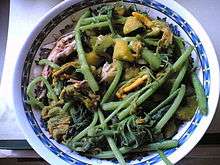 |
Ilocos | A bagoong soup based dish similar to pinakbet. It contains fewer vegetables and contains more bagoong soup base. | |
| Dinuguan |  |
Stew | A savory stew of meat simmered in a rich, thick spicy gravy of pig blood, garlic, chili, and vinegar. | |
| Ginataan | Soup/Stew | Food cooked with gata - the Filipino word for coconut milk. Literally translated, ginataan means "done with coconut milk". Due to the general nature of the term, it can refer to a number of different dishes, each called ginataan, but distinct from one another. Ginataang hipon refers to shrimp cooked in coconut milk, ginataang gulay to an assortment of vegetables cooked in coconut milk, ginataang alimango is mud crabs cooked in coconut milk, while ginataang manok is chickens cooked in coconut milk . Coconut milk can also be added to existing dishes, as in ginataang adobo | ||
| Kare-kare | 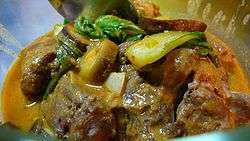 |
Tagalog | Stew | A meat, tripe, and oxtail stew with vegetables in peanut sauce customarily served with bagoong alamang (shrimp paste). |
| Lauya | Ilocos | Soup/Stew | A dish of pork, beef, or carabao meat in broth flavored with ginger, onions and fish sauce served as a soup or main entrée. | |
| Mami |  |
Soup | Generic term for noodle soup. Usually made of beef, chicken, pork. | |
| Menudo | Stew | A stew of pork, pig liver, carrots and potatoes in tomato sauce. | ||
| Nilagang baka | Soup/Stew | A beef stew with cabbages, potatoes, and onion seasoned with fish sauce and black peppercorns usually using beef chuck or brisket. When using beef shank including the bone and marrow it is called nilagang bulalo. | ||
| Pancit Molo | Iloilo | Soup/Stew | A type of soup using wonton wrappers which originated from Molo district in Iloilo City. | |
| Papaitan | Ilocos | Soup/Stew | A sour beef/goat innards soup. The bile or papait (undigested grass juice) is used as the primary souring agent. | |
| Pares | Stew | Filipino word for "Pair". A viand, usually beef asado, served with rice and a bowl of soup | ||
| Pochero |  |
Stew | A beef/pork soup stew, usually nilagang baka, cooked with tomato sauce and pork and beans | |
| Sinanglaw | Ilocos | Soup/Stew | A hotpot made from beef innards. | |
| Sinigang |  |
Soup/Stew | A sour soup/stew made with pork meat, beef or seafood, mixed with a variety of vegetables. Any sour fruit such as tamarind, unripe mango and pineapple is usually used as the souring agent. | |
| Sopas | Noodle Soup | Western style chicken soup. Usually contains chicken strips in broth, onions, vegetables (mainly carrots, cabbage and celery), and macaroni noodles. It is cooked with evaporated milk to give it richer flavor. | ||
| Soup No. 5 | Soup | A soup made from bull's testes or penis. | ||
| Tinola | 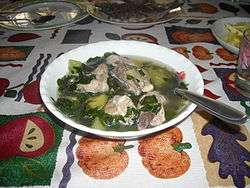 |
Soup/Stew | A dish of chicken, wedges of green papaya, and chili pepper leaves, in broth flavored with ginger, onions and fish sauce served as a soup or main entrée. |
Noodle dishes
| Name | Image | Region | Type | Description |
|---|---|---|---|---|
| Pancit lomi |  |
Noodles | A Chinese-Filipino dish made with a variety of thick fresh egg noodles of about a quarter of an inch in diameter. | |
| Misua |  |
Noodles | A soup, usually of pork broth, with misua (very thin flour noodles). | |
| Pancit luglug | Noodles | Same as pancit palabok except with larger noodles. The name luglug comes from the sound made by the draining of the noodles. | ||
| Pancit canton | Noodles | Chinese-Filipino version of Cantonese lo mein using flour-based noodles. | ||
| Pancit bihon guisado |  |
Noodles | Stir-fried vermicelli noodles with vegetables and pork or chicken. | |
| Pancit Tuguegarao or Batil-patong | Cagayan | Noodles | Pancit originating from the province of Cagayan | |
| Pancit Malabon |  |
Tagalog | Noodles | Another variant of Pancit Palabok which uses shrimp, squid, and other seafoods as toppings. The noodles are thicker than that of the Palabok and Luglug. |
| Pancit estacion | Cavite | Noodles | ||
| Pancit palabok |  |
Noodles | Rice noodles cooked in anato seeds, usually served with hard-boiled egg, chicharon, spring onions, and kalamansi | |
| Filipino spaghetti |  |
Noodles | Filipino version of spaghetti with a tomato (or sometimes banana ketchup) and meat sauce characterized by its sweetness and use of hotdogs or sausages. | |
| Baked macaroni | Noodles | Filipino version of macaroni casserole, with a sauce base similar in flavor to Filipino spaghetti. | ||
| Sotanghon | Noodles | A clear chicken soup with vermicelli noodles (sotanghon). |
Vegetables
| Name | Image | Region | Type | Description |
|---|---|---|---|---|
| Ginisang monggo | 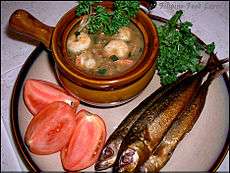 |
Vegetarian | Sauteed mung beans in onions and tomatoes. | |
| Kinilnat | Ilocos | An Ilocano salad made with leaves, shoots, blossoms, or the other parts of the plant are boiled and drained and dressed with bagoong (preferably) or patis, and sometimes souring agents like calamansi or cherry tomatoes are added as well as freshly ground ginger. | ||
| Utan | Cebu | A popular soupy Cebuano dish made of different vegetables like okra, eggplant, malunggay, alugbati, squash, and taro root, yard long beans, tomatoes, season with ginger and bouillon cube and salt served over rice. |
Rice
| Name | Image | Region | Type | Description |
|---|---|---|---|---|
| Arroz a la valenciana | 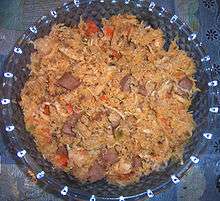 |
Glutinous rice | Includes various diced meats, such as frankfurters/hot dogs, vienna sausage, chorizo de bilbao, carrots, celery, raisins, garlic, and onions mixed with glutinous rice. | |
| Lugaw |  |
Porridge | Plain rice porridge. Not to be confused with Arroz Caldo, which contains chicken. | |
| Champorado | 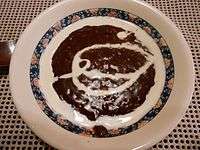 |
Porridge | A sweet chocolate rice porridge. It can be served hot or cold and with milk and sugar to taste. It is served usually at breakfast and sometimes together with dried fish locally known as tuyo. | |
| Paella |  |
Rice | A complex rice dish frequently involving seafood such as shrimps (hipon) and mussels (tahong) taken from Spanish cuisine that is mostly prepared during special occasions. | |
| Sinangag |  |
Rice | Fried rice sauteed in garlic. A vital part of the "silog" meal ("Sinangag at Itlog"; trans: "fried rice and egg"). | |
| Tapsilog |  |
Rice | Refers to the combination of "Beef Tapa, sinangag, at itlog". It is also served with other viands such as Tocino (Tocilog), Hotdog (Hotsilog), and Longganisa (longsilog). |
Preserved meat and fish
| Name | Image | Region | Type | Description |
|---|---|---|---|---|
| Longganisa | Sausage | A pork sausage similar to a chorizo. It has its own regional variants such as Longganisang Ilocano and Longganisang Lucban of the Ilocos Province and of the City of Lucban, Quezon, respectively, that is made with lots of garlic, and Sweet Chorizo of Cebu which is similar to sausages but with a sweeter flavor. | ||
| Tinapa / Tuyo | _(1309812880).jpg) |
Fish preserved through the process of smoking (tinapa) or drying (tuyo). | ||
| Tocino |  |
A cured meat product native to the Philippines. It is usually made out of pork although beef is also used and is cured using sugar which gives it its "ham-like" glaze. |
Pickles and side dishes
| Name | Image | Region | Type | Description |
|---|---|---|---|---|
| Atchara | .jpg) |
Pickle | Refers primarily to unripe papaya in a pickling solution of sugar and vinegar. It also refers to other vegetables pickled in the same manner. | |
| Burong mangga |  |
Pickle | A food made by mixing sugar, salt, and water to unripened mangoes that have previously been salted. | |
| Ensaladang talong | Salad | A salad with boiled/grilled eggplant as the primary ingredient. It can be served as is, in a pickling solution of vinegar and garlic or with tomatoes, onions and bagoong alamang. |
Miscellaneous and street food
| Name | Image | Region | Type | Description |
|---|---|---|---|---|
| Balut | A fertilized duck (or chicken) egg with a nearly developed embryo inside that is boiled, shelled, and eaten as is or dipped in salt or spicy vinegar. | |||
| Binalot |  |
Literally "wrapped". Food wrapped in banana leaves. Usually a meal consisting of a smoked or fried viand and rice sometimes accompanied by a salted egg, tomatoes, or atchara. | ||
| Chicharon |  |
Bulacan | Snack | Primarily refers to fried pork rinds. It is also made from chicken, mutton, beef, fish and fish skin and innards. |
| Fishballs |  |
A common street food most often made from the meat of cuttlefish or pollock and served with a sweet and spicy sauce or with a thick dark brown sweet and sour sauce. | ||
| Isaw |  |
A street food made from barbecued pig or chicken intestines. Another variant is deep-fried breaded chicken intestine. | ||
| Patupat (or Pusô) | 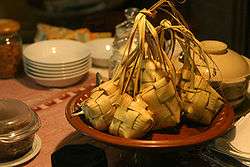 |
A type of rice cake from South East Asia made from rice that has been wrapped in a woven palm leaf pouch or banana leaves then boiled. | ||
| Pinikpikan |  |
Cordillera | A chicken dish wherein the chicken is beaten to death, dressed and roasted whole on a spit. Pinikpik means "beaten (with a hard object)", which is done to infuse the chicken meat with blood. | |
| Siomai |  |
Ground pork, beef, and shrimp, among others, combined with extenders like green peas, carrots and the like which is then wrapped in wonton wrappers. | ||
| Siopao |  |
Steamed filled bun. Common versions are asado, shredded meat in a sweet sauce similar to a Chinese barbecued pork filling, and bola-bola, a packed ground pork filling. | ||
| Tokneneng and Kwek kwek |  |
A tempura-like Filipino street food of duck or quail eggs covered in an orange-dyed batter and then deep-fried. Tokneneng uses duck eggs while the smaller kwek kwek use quail eggs. | ||
| Tokwa at baboy |  |
A bean curd (tokwa is Filipino for tofu, from Lan-nang) and pork dish. Usually serving as an appetizer or for pulutan. Also served with Lugaw |
Bread and pastries
| Name | Image | Region | Type | Description |
|---|---|---|---|---|
| Binaki (Pintos) | _1.jpg) |
Bukidnon, Mindanao; Bogo, Cebu | Tamales | Steamed corn sweet tamales |
| Binangkal | 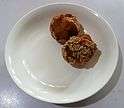 |
Visayas and Mindanao | Fried dough | Hard and crunchy fried flour balls covered in sesame seeds. Not to be confused with buchi, which is hollow and chewy on the inside. |
| Biskotso | Iloilo | Bread | Baked bread topped with butter and sugar, or garlic | |
| Buko Roll | Tuguegarao | Bread | Baked bread filled with coconut and condensed milk | |
| Buchi |  |
Fried dough | A local version of the Chinese sesame seed balls (jin deui). Variants can range from almost exactly the same as the Chinese version, to versions which do not use sesame seeds and are filled with local fillings like ube or bukayo. Also spelled butsi. | |
| Empanada | 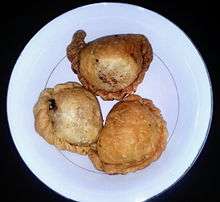 |
Pastry | A baked or fried stuffed bread or pastry. They usually contain ground beef, pork or chicken, potatoes, chopped onions, and raisins. | |
| Ensaymada |  |
Pastry | A pastry or a brioche made with butter (instead of lard) and topped with grated cheese (usually queso de bola, the local name for aged Edam) and sugar. | |
| Pan de coco | Bread | A rich sweet bread with a sweet coconut filling. | ||
| Pandesal |  |
Bread | ||
| Pastel | ||||
| Polvorón |  |
A pastry made from compressed toasted flour, milk, and sugar. Sometimes made with ground peanuts, cashews, and/or pinipig. May be coated with milk and/or milk chocolate. | ||
| Rosquillos | 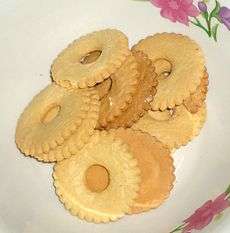 |
Cebu | Cookies | Philippine cookies made from flour, eggs, shortening, sugar, and baking powder. Its name comes from the Spanish word rosca (ringlet).[1][2] Not to be confused with Spanish rosquillos or roscos which are more akin to small doughnuts. |
| Shakoy | %2C_a_doughnut_variant_from_the_Philippines.jpg) |
Visayas | Fried dough | A traditional doughnut variant from the Visayas islands with a distinctive twisted shape. Also known as siyakoy or lubid-lubid. |
| Utap | 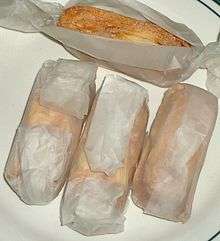 |
Cebu | Pastry | Variant spelling: otap. Oval-shaped puff pastry usually made with flour, shortening, coconut, and sugar. |
Sweets
See also: List of Philippine desserts
| Name | Image | Region | Type | Description |
|---|---|---|---|---|
| Apas | Oblong-shaped biscuits that are topped with sugar. | |||
| Banana cue |  |
Deep fried Saba bananas coated in caramelised brown sugar. | ||
| Barquillos | Iloilo/Negros Occidental | A flat, sweet flour-based pastry rolled into a hollow tube. Sometimes eaten with sorbetes or western ice cream. | ||
| Barquiron | Negros Occidental | Barquillos filled with polvoron. | ||
| Baye baye | 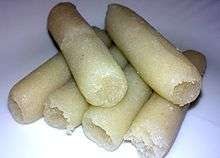 |
Negros Occidental | A sticky dessert made from newly harvested rice. | |
| Belekoy | Bulacan | A sweet pastry made from flour, sugar, sesame seeds, and vanilla. | ||
| Bibingka |  |
A type of cake made with rice flour, sugar, clarified butter, and coconut milk. Baked with coals from above and under, it is usually topped with butter, sugar, and desiccated coconut. | ||
| Binignit | 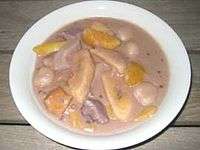 |
A dessert soup made with coconut milk, tubers such as purple yam, sweet potato, and plantains as well as jackfruit, sago and tapioca pearls. | ||
| Biko |  |
A sticky sweet delicacy made from glutinous rice, coconut milk, and brown sugar. It is similar to Kalamay, but uses whole grains. It is also known as Sinukmani or Sinukmaneng. | ||
| Bukayo | A sweet popular with children, it is made by simmering strips of young, gelatinous coconut (buko) in water and then mixing these with sugar. | |||
| Buko pie |  |
A traditional pastry, young coconut filled pie. | ||
| Camote cue |  |
Deep fried kamote with caramelised brown sugar. | ||
| Cascaron | A dessert made of rice flour, coconut and sugar. | |||
| Coconut jam | 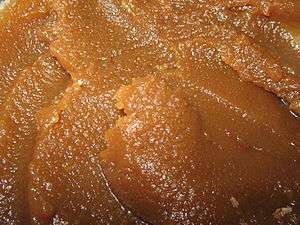 |
A food spread, a custard jam in the general sense, consumed mainly in Southeast Asia and made from a base of coconut and sugar. | ||
| Leche flan |  |
A rich custard made of egg yolks with a layer of soft caramel on top (as opposed to crème brûlée, which has a hard caramel top). Sometimes sliced and added to other desserts such as halo-halo. | ||
| Dodol | Ilocos and Lanao | A toffee-like food delicacy made with coconut milk, jaggery, and rice flour. Sticky, thick and sweet, it is served mostly during festivals such as Eid-ul-Fitr and Eid-ul-Adha. | ||
| Espasol | Laguna | A cylindrical cake made of rice flour cooked in coconut milk and sweetened coconut strips, which is then dusted with toasted rice flour. | ||
| Ginanggang | 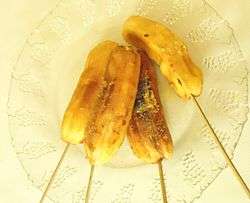 |
Mindanao | Grilled skewered Saba bananas brushed with margarine and sprinkled with sugar. | |
| Halo-halo | 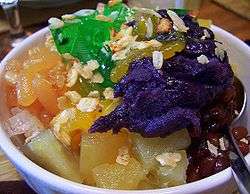 |
A popular dessert that is a mixture of shaved ice and milk to which are added various boiled sweet beans and fruits, and served cold in a tall glass or bowl. | ||
| Hopia |  |
A popular bean filled pastry originally introduced by Fujianese immigrants in urban centres of the Philippines. | ||
| Kalamay |  |
A sticky sweet delicacy made of ground glutinous rice, grated coconut, brown sugar, margarine, peanut butter, and vanilla (optional). | ||
| Kutsinta | Rice cake with jelly-like consistency made from rice flour, brown sugar, lye and food coloring, usually topped with freshly grated mature coconut | |||
| Latik | 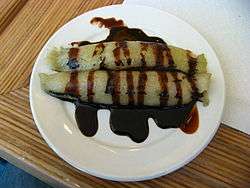 |
Latík in the northern Philippines refers to coconut milk curds used as toppings. In the Visayan regions, it refers to a thick, sweet syrup made from coconut milk and sugar. | ||
| Maíz con hielo | Similar to halo-halo, but instead made with corn kernels and sometimes with corn flakes as topping. | |||
| Maja blanca |  |
A local variant of blancmange made of coconut milk and corn starch. May include sweet corn kernels. | ||
| Maruya | .jpg) |
Fritters usually made from Saba bananas. | ||
| Moron | Moron made from glutinous rice with two different flavors chocolate and with coconut milk | |||
| Nata de coco | ||||
| Palitaw |  |
They are made from malagkít (sticky rice) washed, soaked, and then ground. Scoops of the batter are dropped into boiling water where they float to the surface as flat discs which are then dipped in grated coconut and presented with a separate dip of sugar and toasted sesame seeds. | ||
| Piaya | Negros Occidental | Snack | A flat pastry filled with a jam made of muscovado sugar and sometimes sprinkled with sesame seeds, grilled on a pan. Different flavours include ube (purple yam), mango and chocolate. | |
| Puto |  |
Small white buns baked from rice flour. Variations include ube and pandan flavours, as well as toppings like cheese and salted duck egg. Sometimes used to accompany other dishes, usually dinuguan (black pudding stew). | ||
| Sapin-sapin | 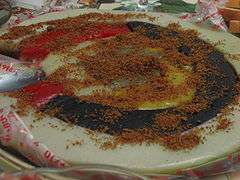 |
A layered glutinous rice and coconut dessert. Takes its name from the word sapin, "to spread" or "to cover". | ||
| Sorbetes |  |
Traditional Filipino ice cream. Usually peddled by a sorbetero from a brightly coloured pushcart, it is sometimes made with coconut milk or rarely carabao milk. Typical flavours include ube, cheese, cookies and cream, avocado, strawberry, Chocnut (a popular crumbly chocolate and peanut sweet), and melon. Sorbetes is can be served on a cone, in a cup, or on bread such as pan de sal or hotdog buns. | ||
| Suman |  |
Sticky rice steamed in banana leaf. Topped with a traditional brown sauce or sugar. | ||
| Taho |  |
Made with fresh tofu, arnibal (a brown sugar and vanilla syrup), and sago pearls. Usually sold in the morning by a hawker known as a magtatahô and can be eaten as a breakfast. May be served either hot (straight from the magtatahô) or sometimes it can be purchased chilled. Probably developed from the Chinese treat douhua. | ||
| Turrón |  |
A typical Philippine snack consisting of a banana or plaintain and maybe jackfruit wrapped in a springroll wrapper then deep fried and sprinkled with sugar. | ||
| Ube halaya | 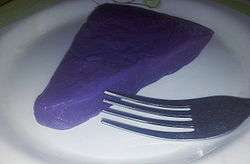 |
Ube jam, made from boiled and mashed purple yam. Ube halaya (Or halayang ube; variant spellings halea, haleya; from the Spanish jalea, "jam") is also used in pastries and other desserts such as halo-halo and ice cream. |
Sauces and condiments
| Name | Image | Region | Type | Description |
|---|---|---|---|---|
| Alamang (Shrimp paste) | Shrimp paste made from minute shrimp or krill. | |||
| Bagoong monamon |  |
Pangasinan | A common ingredient used in the Philippines and particularly in Northern Ilocano cuisine. It is made by fermenting salted anchovies. | |
| Bagoong terong | 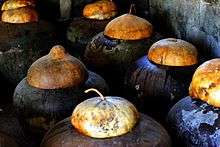 |
It is made by salting and fermenting the bonnet mouth fish. This bagoong is coarser than Bagoong monamon, and contains fragments of the salted and fermented fish. | ||
| Banana ketchup |  |
A prepared condiment made from banana fruit mashed, with sugar, vinegar, and spices, and colored with red food coloring. | ||
| Lechon sauce | Also known as liver sauce or breadcrumb sauce made out of ground liver or liver pâté, vinegar, sugar, and spices. A sweet, tangy light-brown sauce used in roasts and the pork dish called lechon | |||
| Oyster sauce |  |
|||
| Patis (Fish sauce) | Sometimes spiced with labuyo peppers, or kalamansi lime juice | |||
| Peanut sauce |  |
|||
| Tultul |  |
Guimaras | A type of rock salt. | |
| Suka (Vinegar) | ||||
| Toyo (Soy sauce) |
Drinks
| Name | Image | Region | Type | Description |
|---|---|---|---|---|
| Basi | Ilocos | Alcoholic beverage | Made from sugar cane. If fermented longer, it turns into suka or vinegar. | |
| Buko juice |  |
Coconut water. The water inside a coconut. | ||
| Tuba (Palm wine) | Alcoholic beverage | |||
| Lambanog | Southern Tagalog (Batangas, Laguna and Quezon Province) | Alcoholic beverage | Wine made of nipa palm or coconut. Sometimes known in Asia as arrack or coconut vodka. |
Ingredients
| Name | Image | Region | Type | Description |
|---|---|---|---|---|
| Atsuete (Annatto seeds) |  |
Frequently used as a food coloring in dishes like kare-kare. | ||
| Ampalaya (Bitter melon) | 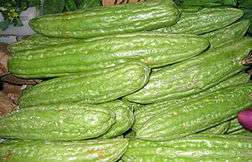 |
Vegetable | ||
| Bangus (Milkfish) |  |
Pangasinan | Fish | Generally considered the national fish of the Philippines. Popular dishes include daing na bangus, rellenong bangus, and sinigang na bangus. |
| Batuan | Fruit | |||
| Bawang (Garlic) |  |
Spice | ||
| Bayabas (Guava) |  |
Fruit | ||
| Bay leaf (Dahon ng Laurel) |  |
Spice | Referred to as "dahong paminta" (literally 'spice leaf') or "dahong laurel" | |
| Bulaklak ng saging (Banana blossoms) | 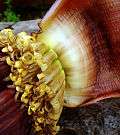 |
Flavoring | Used as an ingredient ing kare-kare | |
| Calabaza | Vegetable | |||
| Gabi (Taro corm) |  |
Root crop | ||
| Gata (Coconut milk) | ||||
| Glutinous rice |  |
Grain | ||
| Gulaman |  |
An edible thickening agent used to make jellies, flan, or desserts derived from dried seaweed. | ||
| Kanin (Rice) |  |
Grain | Called bigas when uncooked and kanin when cooked. | |
| Kalamansi (Calamondin) | Fruit | |||
| Kamote (Sweet potato) |  |
Root crop | ||
| Kamoteng Kahoy (Cassava) | 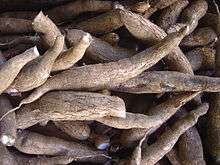 |
|||
| Kamatis (Tomato) | 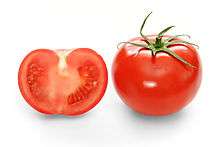 |
Fruit | ||
| Kangkong (Water spinach) | 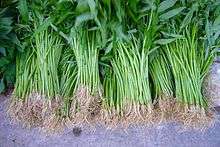 |
Vegetable | A semi-aquatic tropical plant grown as a leaf vegetable. | |
| Kesong puti or Kasilyo | 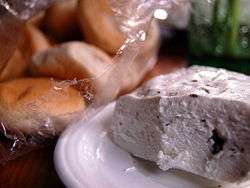 |
Cavite, Laguna, Bulacan, Samar, and Cebu | Cheese | A soft, white cheese, made from unskimmed carabao's milk, salt, and rennet. |
| Katuray | 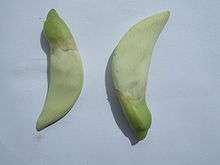 |
Flower | ||
| Kinampay |  |
Bohol | A specific variety of ube which is found mostly in Bohol, Philippines. | |
| Kundol (Winter melon) | 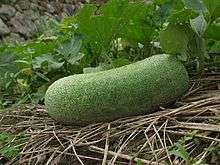 |
Vegetable | ||
| Labanos (Daikon radish) |  |
Vegetable | ||
| Lapu-lapu (Grouper) | Fish | |||
| Luya (Ginger) | Spice | |||
| Malunggay (Moringa) |  |
Vegetable | ||
| Mangga (Mango) |  |
Fruit | Generally considered the national fruit of the Philippines. Frequently eaten ripe as it is or when unripe with bagoong or used as an ingredient in dishes. | |
| Monggo (Mung bean) | 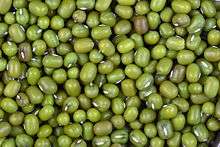 |
Bean | ||
| Okra | 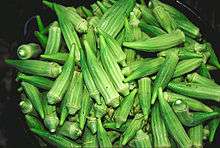 |
Vegetable | ||
| Paminta (Black pepper) |  |
Spice | Sometimes referred to as "butong paminta" (literally 'seed spice') to distinguish it from bay leaves ("dahong paminta") | |
| Patola (Luffa) | 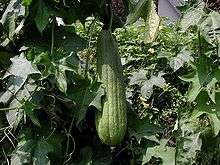 |
Vegetable | ||
| Pechay (Chinese cabbage) |  |
Vegetable | ||
| Pechay wombok (Napa cabbage) | 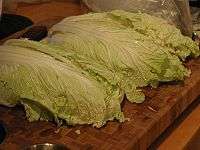 |
Vegetable | ||
| Pili Nut | .jpg) |
Nut | A type of nut belonging to the genus Canarium. Mostly used in desserts, the edible nut is cultivated only in the Philippines. | |
| Puso ng saging (Banana heart) |  |
|||
| Repolyo (Cabbage) |  |
Vegetable | ||
| Saba | Berry | A short wide plaintain that is often used in cooking. The other two kinds of saging (bananas) common in local markets are the dessert cultivars latundan and lakatan. | ||
| Sayote (Chayote) | 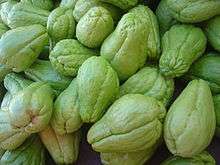 |
Vegetable | ||
| Sibuyas (Onion) |  |
Spice | ||
| Siling labuyo | 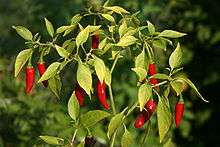 |
Spice | Bird's eye chili, one of the hottest chili varieties. | |
| Siling mahaba | Spice | |||
| Singkamas (Jícama) | 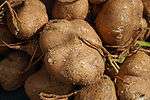 |
Root crop | Sometimes eaten raw and dipped in salt. | |
| Sitaw (Yardlong bean) | 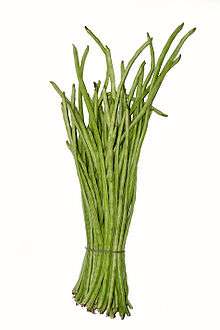 |
Bean | ||
| Sitsaro (Snow peas) | 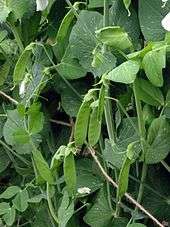 |
Pea | ||
| Tabon-tabon |  |
Fruit | A type of fruit used as souring agent and antiseptic in local dishes especially Kinilaw. Records show that ancient Filipinos used this already as an ingredient predating Spanish colonization. | |
| Talong (Eggplant) |  |
Fruit | ||
| Tausi (Fermented black beans) |  |
Bean | Usually sold in cans. | |
| Tilapia | 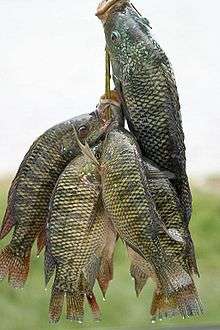 |
Fish | ||
| Tofu |  |
Usually dried tofu or tokwa. Sometimes added as an optional ingredient in some vegetable dishes. Silken tofu is usually associated with the snack or dessert taho (see above) which sees it mixed with a sweet syrup. | ||
| Togue (Bean sprouts) |  |
|||
| Ube (Purple yam) |  |
Root crop | ||
| Wansoy (Coriander leaf or cilantro) |
See also
References
- ↑ Lovebel G. Talisic. "Titay's Liloan Rosquillos and Delicacies: Liloan Pride". OneCebu. Retrieved July 9, 2012.
- ↑ Burt Lao. "Titay's Rosquillos". Everything Cebu. Retrieved July 9, 2012.
External links
| Wikimedia Commons has media related to Cuisine of the Philippines. |
| Wikibooks Cookbook has a recipe/module on |
This article is issued from Wikipedia - version of the 12/1/2016. The text is available under the Creative Commons Attribution/Share Alike but additional terms may apply for the media files.
